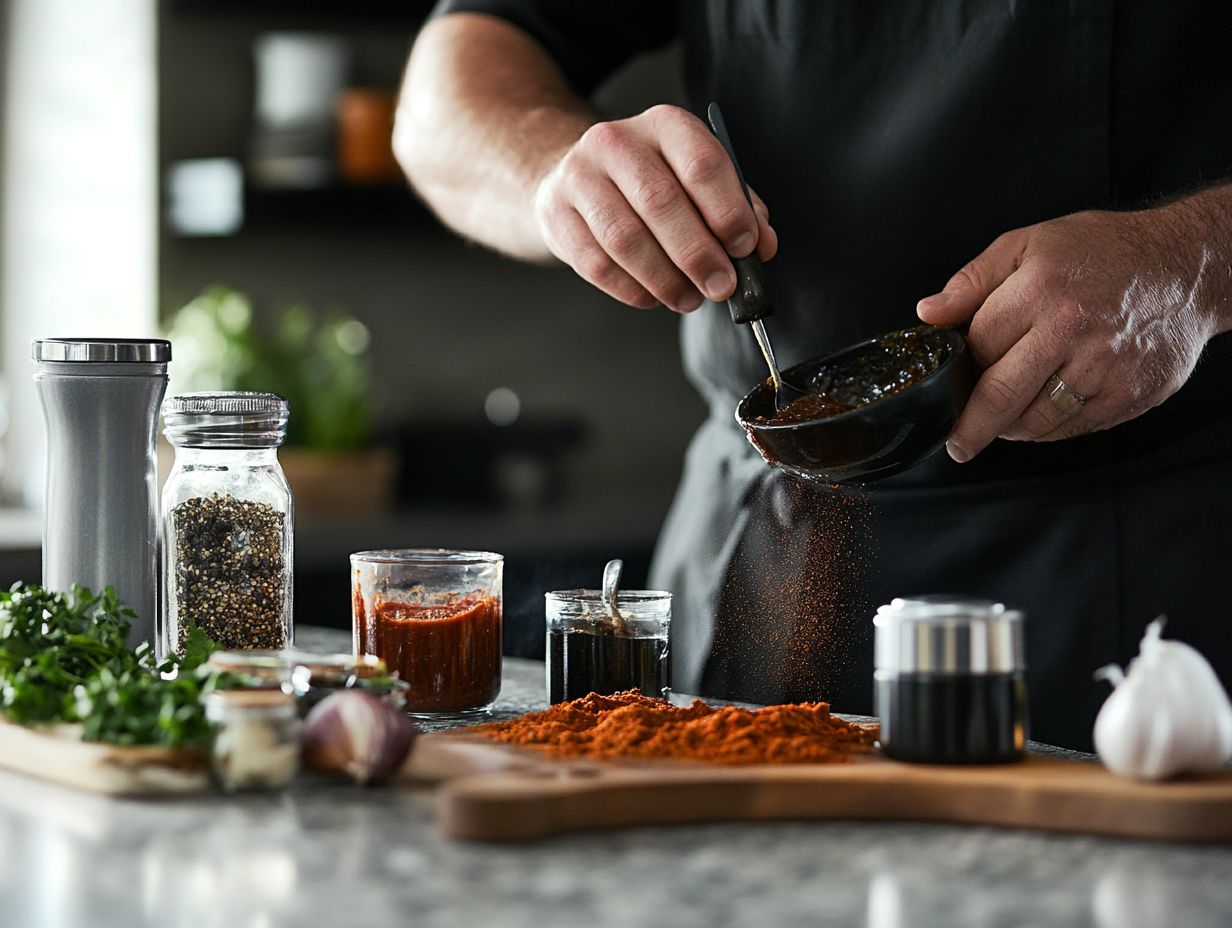Understanding and Fixing Flavor Imbalance
Flavor is an essential element in cooking that can truly make or break a dish. When flavors clash or fail to shine, it leads to a lack of balance that can disappoint even the most discerning palate. Understanding food flavors and seasoning tips can help avoid these kitchen mishaps.
This article explores the various causes behind culinary conundrums, such as underseasoning, ingredient proportions, and cooking techniques. You ll discover how to identify these imbalances through taste and smell tests, along with practical solutions to restore harmony to your meals using effective cooking methods and flavor balancing.
Get ready to transform your cooking and impress your guests!
Contents
- Key Takeaways:
- What Is Flavor Imbalance?
- What Causes Flavor Imbalance?
- How to Identify Flavor Imbalance?
- Flavor Testing Techniques
- How to Fix Flavor Imbalance?
- Frequently Asked Questions
- What causes flavor imbalance in food?
- How can I tell if my dish has flavor imbalance?
- What can I do to fix flavor imbalance in my dish?
- Can I use any ingredient to fix flavor imbalance?
- How can I prevent flavor imbalance in the future?
- What if my dish still has flavor imbalance after trying these cooking techniques and seasoning tips?
Key Takeaways:

- Flavor imbalance occurs when the taste, smell, or appearance of a dish is not well-balanced, leading to an unsatisfactory culinary experience.
- Common causes of flavor imbalance include underseasoning, overseasoning, ingredient imbalance, and improper cooking methods.
- To fix flavor imbalance, adjust seasonings, dilute with neutral ingredients like coconut milk, add acidic ingredients such as vinegar or lemon juice, add sweetness, or balance with opposing flavors.
What Is Flavor Imbalance?
Flavor imbalance happens when the essential taste elements in a dish sweetness, sourness, bitterness, saltiness, and umami aren t properly harmonized. This often results in an uninspiring culinary experience. Proper ingredient balance is key to achieving the perfect harmony of flavors.
This imbalance can occur when recipes overlook the correct proportions of these flavors, leading to dishes that are excessively sweet, overly salty, or simply lacking in depth.
Mastering the art of flavor balance is crucial for any cooking enthusiast. It profoundly influences the overall enjoyment of food and the success of recipes, especially when utilizing common ingredients and various cooking techniques.
What Causes Flavor Imbalance?
Flavor imbalance can arise from various factors during the cooking process. These include underseasoning or overseasoning, ingredient imbalance, and cooking methods that do not showcase the unique qualities of the ingredients, such as improper salt usage or neglecting the impact of sour ingredients like vinegar.
Understanding these causes is essential for elevating the taste of your creations and achieving the perfect harmony of flavors. For example, using too much salt or overly sweet ingredients like sugar can overshadow the intended flavor profiles. Conversely, neglecting sour elements, such as vinegar, can leave your dish tasting disappointingly flat.
Recognizing these potential pitfalls is your first step toward mastering the art of cooking and crafting truly delightful recipes. Incorporating kitchen tips from experts can further enhance your culinary journey.
1. Underseasoning
Underseasoning occurs when flavors, especially salt and spices, are applied inadequately. This leads to a dish that feels bland and uninviting, failing to engage your palate and detracting from your culinary experience. It is important to make taste adjustments throughout the cooking process.
When meals lack seasoning, they often miss the complexity and depth that enhance enjoyment. This can result in dissatisfaction and make you hesitant to revisit certain recipes. For instance, a simple chicken breast, with the right blend of herbs and spices think rosemary or paprika can transform from mundane to mouthwatering, underscoring the crucial role of careful seasoning.
To avoid the pitfalls of underseasoning, consider employing techniques such as tasting as you cook. Gradually adding salt or spices allows you to gauge their effect on the dish. In stews or soups, just a pinch of salt can unlock natural flavors, making them pop with vibrancy. Don t overlook the power of acidity a squeeze of lemon juice or adding pickles can elevate overall flavor profiles, ensuring that every meal is truly memorable.
In conclusion, understanding and addressing flavor imbalance is essential for creating dishes that delight the palate. By mastering seasoning and cooking techniques, you can elevate your culinary skills and impress everyone at your table.
2. Overseasoning
Overseasoning happens when you go a bit overboard with salt, sugar, or spices, overshadowing the intended flavors of your dish. This leads to an unbalanced culinary experience that certainly doesn’t leave a delightful impression on your diners, potentially ruining the hard work you put into food preparation.
This issue often arises from the misguided belief that more seasoning means more flavor. In reality, ingredients like salt and sugar can easily drown out the delicate notes of herbs and spices that truly capture a dish’s essence. For example, if you add too much salt, you risk masking the natural sweetness of your vegetables. An overabundance of sugar can dull savory flavors.
To correct this imbalance, you might think about diluting overly seasoned sauces with some unsalted broth or introducing an acidic element like vinegar or lemon juice to cut through the excess. By gradually adjusting the seasonings, you can create a harmonious blend that elevates the dish while preserving its original character. These cooking tips can make a significant difference in your culinary endeavors.
3. Ingredient Imbalance
Ingredient imbalance arises when the proportions of certain components lean too heavily in one direction, disturbing the balance of flavors. This can result in a dish that tastes excessively sweet due to too much sugar, bitter from dark leafy greens, or salty due to a lack of equilibrium among its elements.
For example, if you use too many dark leafy greens without balancing them with enough acidity, you could end up with a dish that’s excessively bitter. Likewise, an overabundance of chocolate in a dessert can easily overshadow the more subtle flavors, rendering the overall experience rather one-dimensional.
To tackle these challenges and achieve a more harmonious flavor profile, you can employ various techniques, such as fine-tuning the seasoning and introducing contrasting elements. A splash of citrus or a hint of fresh herbs can significantly elevate the dish’s taste, allowing the natural sweetness of your ingredients to shine while tempering any bitterness. Including nuts or avocados can also add a different texture and richness.
By using seasoning tips thoughtfully, you can truly enhance the nuances of your dish, guiding the palate toward a more gratifying experience.
4. Cooking Methods

The cooking method you choose can dramatically influence the balance of flavors in your dish. Techniques such as boiling, saut ing, or roasting can either enhance or dull specific flavors, ultimately shaping your cooking experience. If not executed with care, you may end up with an undesired taste that leaves much to be desired. Refined cooking techniques and tasting food at different stages can help achieve the desired flavor profile.
Take roasting sweet ingredients like sweet potatoes, for example. This method caramelizes their natural sugars, creating a rich depth of flavor that boiling simply cannot replicate. When you boil these ingredients, they tend to lose some of their inherent sweetness, resulting in a more muted flavor profile.
Selecting the right cooking method is essential for achieving the taste you desire. While saut ing can deliver a quick and vibrant burst of flavor through the use of fats and aromatics, other methods like steaming might preserve more nutrients but may not develop flavors to the same extent.
By grasping the nuances of these cooking techniques, you can better balance flavors and elevate your dining experience, making every meal a potential culinary masterpiece.
How to Identify Flavor Imbalance?
Identifying flavor imbalance in a dish requires a thoughtful blend of techniques such as taste tests, smell assessments, and visual inspections. These methods will give you the power to discern whether the flavors are in harmony or if they need a little tweaking. Using kitchen advice from experts like Elizabeth Laseter can also be beneficial.
By immersing yourself in the dish through these approaches, you ll gain a deeper understanding of its flavor profile, enabling you to make informed decisions on how to enhance or correct it. Tasting the food at various stages of preparation can unveil critical insights that guide necessary adjustments. The aroma and appearance can hint at potential issues with ingredient balance and seasoning techniques.
Flavor Testing Techniques
1. Taste Test
A taste test helps you spot flavor imbalances. It allows you to check the overall taste of a dish before serving, ensuring a satisfying culinary experience.
Engaging in a taste test invites you to savor each component individually, from the sweetness of a sauce to the acidity of a vinaigrette. Pay close attention to how these elements interact and whether any particular flavor dominates the palate in an unwelcome way.
When evaluating your dishes, consider textural contrast the difference in texture that adds interest to food. This can significantly enhance your overall tasting experience. Recipes from sources like Cooking Light and EatingWell can provide valuable guidance in this area.
Incorporating various cooking techniques can elevate your flavors, adding depth and complexity. By breaking down each layer of flavor, you can achieve a harmonious balance that delights the senses and transforms any meal into a great dish. Learning from culinary institutions like the James Beard Foundation or browsing top recipes from Allrecipes and MyRecipes can offer new insights into perfecting your dishes.
2. Smell Test
The smell test is a crucial yet often underestimated technique for detecting flavor imbalances. The aroma of a dish can reveal discrepancies in sweetness, acidity, or seasoning even before you take a bite. For example, the rich aroma of French Onion Soup can indicate the perfect caramelization of onions, while an off-putting smell suggests something is amiss.
Don t skip the smell test! It s your first clue to the dish s success. An overly sweet aroma might signal excess sugar or syrup, while an intense, pungent scent could indicate some ingredients have been overcooked. Using herbs and spices from trusted sources like Whole Foods Market can ensure quality and consistency in your dishes.
By paying attention to these distinctive fragrances, you can make necessary adjustments before presenting your meal. Ensure that the aromas of herbs and spices work together harmoniously, creating a well-rounded flavor profile.
Understanding these signals enriches your culinary experience and elevates the final presentation, ensuring each dish resonates with a sense of balance and depth in terms of food flavors.
3. Visual Inspection
A visual inspection of a dish offers crucial insights into potential flavor imbalances. By observing the colors and textures, you can determine whether certain ingredients overshadow or lack in creating a balanced culinary experience. This step is vital in the food preparation process.
For instance, the vibrant green from fresh herbs can create a stunning contrast against the earthy tones of roasted vegetables, signaling a delightful harmony between freshness and depth. Conversely, if you notice a sauce that is overly glossy and rich in color, it may indicate excess fat or salt an indicator that the dish could benefit from a splash of acidity or a hint of spices to elevate the overall flavor profile.
Uneven textures, like a sauce that appears too thick or chunky, can reveal a missed opportunity for a refined mouthfeel, which is essential for a truly well-rounded dining experience. Focusing on these visual details ensures that every component not only tastes exceptional but also presents beautifully, ultimately enhancing your culinary journey. Whether preparing French Onion Soup or a simple vinaigrette, attention to texture is key.
How to Fix Flavor Imbalance?
Fixing flavor imbalance is crucial for elevating your dishes to new culinary heights. You can achieve this through adjusting seasonings, diluting with neutral ingredients, or introducing elements of acidity and sweetness. This process requires careful taste adjustments and consideration of ingredient balance to create a more harmonious dining experience.
By understanding the roles of different flavors, you can make informed adjustments that significantly enhance your creations. For instance, if you find a dish is too salty, incorporate a neutral ingredient like coconut milk or dark leafy greens to effectively tone down the saltiness. A splash of lemon juice can also work wonders, brightening flavors and bringing a delightful balance to the plate. This advice is often highlighted in resources like EatingWell and MyRecipes.
1. Adjust Seasonings

Adjusting seasonings is one of the simplest yet most effective strategies for rectifying flavor imbalances, allowing you to fine-tune the taste of your dish until it reaches your desired flavor profile. This is especially true when dealing with sour ingredients or umami flavors.
By understanding the nuances of various ingredients like how salt can enhance sweetness or how acidity can balance savory elements you can create dishes that truly tantalize the palate. For example, if your tomato-based sauce leans too heavily on the acidic side, a pinch of sugar can work wonders to mellow that tanginess, bringing harmony to the overall flavor. On the flip side, if a dish feels flat, a dash of salt can elevate the other flavors, infusing depth and brightness.
Don t hesitate to experiment with herbs and spices; a sprinkle of fresh basil or a hint of cinnamon can elevate an ordinary soup into an extraordinary culinary experience.
2. Dilute with Neutral Ingredients
Diluting a dish with neutral ingredients is your secret weapon for counteracting overpowering flavors, helping you restore balance and elevate your overall culinary experience.
Take coconut milk, for example. It not only adds a creamy texture but also introduces a subtle sweetness that can soften those harsh spices in a curry. Similarly, avocados bring their rich, buttery goodness to the table, creating a luxurious mouthfeel while toning down acidity in salsas or dressings.
Neutral ingredients enhance your dish and contribute to a harmonious blend of flavors. They transform overwhelming experiences into balanced ones. By thoughtfully selecting the right diluting agents, you can elevate any meal and address flavor imbalances, allowing each component to shine without competing fiercely for attention. Culinary experts, including those from the James Beard Foundation, passionately recommend this approach for achieving flavor balance and elevating your meals.
3. Add Acidic Ingredients
Incorporating acidic ingredients like vinegar or lemon juice can elevate your dishes, infusing them with brightness and balance while effectively correcting any flavor imbalances that might leave a dish feeling dull or flat.
This subtle touch can transform your culinary experience, enhancing flavors and stimulating the palate. For example, when you add a splash of balsamic vinegar to a salad, it enhances the earthy notes of the greens while cutting through any heaviness. A simple drizzle of fresh lime juice over grilled fish not only elevates the dish but also beautifully balances the richness of the protein.
Other acidic components, such as yogurt, tamarind, or even tomatoes, introduce layers of complexity, ensuring that each bite resonates with vibrant taste. By understanding how these elements harmonize, you can unlock the full potential of any recipe.
4. Add Sweetness
Adding a touch of s sweetness whether from sugar, honey, or delightful ingredients like chocolate or sweet potatoes can effectively counterbalance bitterness or sourness in your dishes, resulting in a more enjoyable culinary experience. Sweet ingredients can be the key to transforming the overall taste of your dish.
Adding a touch of s sweetness whether from sugar, honey, or delightful ingredients like chocolate or sweet potatoes can effectively counterbalance bitterness or sourness in your dishes, resulting in a more enjoyable culinary experience.
This harmonious balance has the power to transform an ordinary meal into something truly extraordinary. For example, when you re crafting a savory sauce, incorporating a hint of honey or maple syrup can beautifully soften those harsh acidic notes, creating a luxurious depth of flavor.
Similarly, tossing in fruits like ripe mangoes or peaches into your savory salads not only introduces refreshing sweetness but also adds vibrant textures that elevate the dish. Even in the realm of baking, the choice between brown sugar and white sugar can significantly shift the flavor profile, enhancing the overall richness of your treats.
Ultimately, grasping how sweetness interacts with other taste components is essential for any home cook aspiring to elevate their culinary creations.
5. Balance with Opposing Flavors
Balancing flavors by introducing opposing elements, such as combining bitter ingredients with sweet ones, allows you to create a complex and enticing dish that elevates the entire culinary experience.
This technique doesn’t just thrill the palate; it invites diners to savor each bite in an entirely new and delightful manner. Imagine indulging in a rich chocolate dessert, perfectly complemented by a hint of sea salt, or a tart cherry coulis that cuts through the sweetness these examples vividly demonstrate how contrasting flavors can elevate a dish to extraordinary heights.
Similarly, consider a well-crafted vinaigrette that unites the bitterness of arugula with the sweetness of roasted beets, showcasing the harmonious interplay of contrasting elements. By grasping these principles, you can steer clear of flavor imbalances, ensuring each component plays its unique role in the overall symphony of tastes.
This approach culminates in memorable culinary experiences that will linger in the minds of diners long after the last bite.
6. Cook Longer or at a Different Temperature
Cooking for longer periods or at varying temperatures can truly transform the flavors of your dishes, allowing for a depth of taste that elevates your culinary creations while addressing any flavor imbalances.
Consider the magic of slow cooking a hearty beef stew at low temperatures. This method not only tenderizes the meat but also encourages the rich flavors of the broth, vegetables, and spices to blend seamlessly, resulting in an unforgettable depth of flavor that quick cooking simply cannot replicate. Slow cooking advice can be found in resources like MyRecipes and Cooking Light.
Similarly, when it comes to baking, adjusting oven temperatures can yield remarkable outcomes. High-heat roasting can caramelize vegetables, enhancing their natural sweetness, while a gentler temperature ensures even cooking perfect for layered dishes like lasagna, where each flavor needs time to harmonize fully. Using common ingredients like sweet potatoes in baking can also enhance the overall flavor profile.
By mastering these techniques, you can elevate your cooking and unlock a world of delightful new flavors.
Frequently Asked Questions

What causes flavor imbalance in food?
Flavor imbalance in food can be caused by various factors, such as using too much or too little of certain ingredients, using low-quality ingredients, or improper cooking techniques.
Common kitchen mishaps can also lead to these imbalances.
How can I tell if my dish has flavor imbalance?
If your dish lacks depth or complexity of flavor, has a dominant or overwhelming taste, or shows an imbalance between sweet, salty, sour, and umami flavors, it is likely experiencing flavor imbalance.
Taste your food while cooking to catch imbalances early.
What can I do to fix flavor imbalance in my dish?
To fix flavor imbalance, try adjusting the amount of certain ingredients. For example, add more acid to counter sweetness or more salt to enhance savory flavors.
Experiment with different cooking techniques and add herbs and spices for more complexity. Check out Allrecipes and MyRecipes for fantastic seasoning tips that can transform your dish!
Can I use any ingredient to fix flavor imbalance?
While some ingredients, like acid or salt, can help balance flavors, it’s important to use ingredients that complement the existing flavors in your dish.
Experiment with different herbs, spices, and condiments to find the right balance. Common ingredients like vinegar, sugar, and chocolate can also help achieve the perfect balance.
How can I prevent flavor imbalance in the future?
To prevent flavor imbalance, understand the roles of each ingredient. Use high-quality herbs and spices, and always follow recipes closely for the best results.
Cooking advice from reputable sources, like EatingWell, Whole Foods Market, and Allrecipes, can provide valuable insights. Practice regular tasting and make incremental adjustments as needed to maintain a harmonious balance of flavors.
What if my dish still has flavor imbalance after trying these cooking techniques and seasoning tips?
If your dish still has flavor imbalance after adjusting ingredients and trying different techniques, it may be best to start over with a new batch.
Consider seeking advice from a professional chef or experienced cook for additional tips. Incorporate common ingredients like vinegar, sugar, salt, lemon juice, and coconut milk to balance food flavors.
For culinary expertise, refer to experts like Elizabeth Laseter from Whole Foods Market, or resources like Cooking Light, EatingWell, MyRecipes, Allrecipes, and the James Beard Foundation.
Got more questions? Feel free to ask in the comments below!






